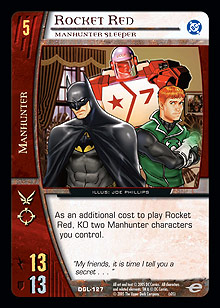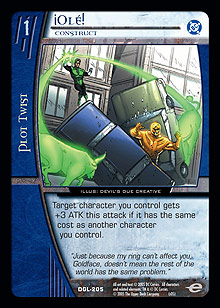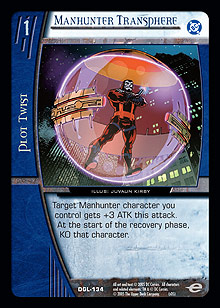
If you were here last week, you no doubt caught “The” Ben Seck’s GL Willpower Draft article. Leave it to TBS to provide draft tips for an archetype you could fall into and draft successfully. I exaggerate slightly, of course, but there’s so much willpower in the set that it’s more difficult not to draft willpower than anything else. Perhaps it’s all for the best, as today’s article will focus on drafting the only team lacking significant willpower in the Green Lantern expansion—the Manhunters.
The View – General Manhunting Strategy
 The Manhunter team offers a unique draft pattern because of its lack of willpower. That, combined with the presence of heavily team-stamped characters (like Mark Shaw and Rocket Red), allows you to focus on premium support cards while others are scrambling for willpower cards. The predominance of exhaust costs and KO effects on Manhunter cards means that it is critical to develop an early board position and have an excess of characters. This strategy is enabled by the 3-cost Manhunters and concealed characters, but as we’ll see, depending on some of these cards in draft can often lead you astray.
The Manhunter team offers a unique draft pattern because of its lack of willpower. That, combined with the presence of heavily team-stamped characters (like Mark Shaw and Rocket Red), allows you to focus on premium support cards while others are scrambling for willpower cards. The predominance of exhaust costs and KO effects on Manhunter cards means that it is critical to develop an early board position and have an excess of characters. This strategy is enabled by the 3-cost Manhunters and concealed characters, but as we’ll see, depending on some of these cards in draft can often lead you astray.
Satin Coffins – Where Things Can Go Wrong
It’s a common misconception that Manhunters in Draft focus on 3-drops, Shock Troops, and ¡Ole!. While low cost characters offset much of the cost associated with the Manhunter team, that doesn’t necessarily mean that you should spend your early picks on cards that require you to have two characters of the same cost in play. These plot twists appear late in a draft for good reason—they are so narrow that the only team that can justify picking them is the Manhunters, and even then, a density of characters of the same cost is required before they can be played. It’s generally accepted that using plot twists before turn 4 is a waste unless you’re playing an overly aggressive off-curve deck and have the opportunity to reverse initiatives, so if you’re busting Shock Troops on your second 2-drop, chances are that things are going poorly. All this implies that there are actually two divergent Manhunter builds—one that uses 3-cost Manhunters for turns 3 and 4 and the corresponding plot twists, and another that follows a traditional curve beginning turn 4. Mixing the two builds results in an inconsistent turn 4 and greatly devalues the shared-cost plot twists. Early in the draft, avoid shared-cost plot twists and concentrate on generic plot twists and establishing a strong Manhunter character base that straddles the 3- and 4-drop decision point. If Mark Shaw turns up, strongly consider ditching the shared-cost path and focusing on concealed low-drops to supply you with characters to exhaust and KO for Rocket Red.
The Good Things – The Manhunter Core
 Mark Shaw – In a set with high-DEF 4-drops, consistent ways to pump your 4-drops’ ATKs are welcome. In a team that has cheap card draw and KO pile recursion, Mark Shaw fits this requirement well and has a butt that will force plot twists from your opponent. Combined with Rocket Red, the imbalance created on turns 4 and 5 can decimate your opponent’s board and exhaust him or her of plot twists before the critical turn 6. Mark Shaw greatly increases the value of already solid picks like Manhunter Science, Plans Within Plans, and Only a Friend Can Betray You.
Mark Shaw – In a set with high-DEF 4-drops, consistent ways to pump your 4-drops’ ATKs are welcome. In a team that has cheap card draw and KO pile recursion, Mark Shaw fits this requirement well and has a butt that will force plot twists from your opponent. Combined with Rocket Red, the imbalance created on turns 4 and 5 can decimate your opponent’s board and exhaust him or her of plot twists before the critical turn 6. Mark Shaw greatly increases the value of already solid picks like Manhunter Science, Plans Within Plans, and Only a Friend Can Betray You.
Lanterns in Love – A reasonably high pick in any deck, the prevalence of hidden and low cost characters in your deck makes Lanterns an extremely high pick. The fact that the marquee Manhunter characters are heavily team-stamped or otherwise unspectacular when splashed allows you to prioritize generic plot twists such as Lanterns and attack pumps early in packs. The complexity of drafting Manhunters is alleviated by the fact that the lack of willpower on your team means that your high picks rarely overlap with others’. As an exercise in reading draft signals, your deck can draft itself if you’ve correctly evaluated the table.
Rocket Red – The big payoff for drafting concealed characters and recovery effects, Rocket Red’s over-the-top stats are exceptional relative to the stats of the other common 5-drops in the set. That being said, Rocket Red is the reason to play odd initiatives. After you’ve paid his recruit cost, it’s unlikely that you will have any other characters besides your 4-drop to protect him, so taking the odd initiative prevents your opponent from simply team-attacking into him. On the following initiative, you can protect Red or your 6-drop comfortably behind your 4-drop and make it extremely difficult for your opponent to have a productive turn.
Manhunter Science – A strong play in the early turns on either initiative, Manhunter Science allows you to play more low cost characters in your deck without sacrificing the consistency of later turns. Mark Shaw’s power and the playing of low-drop characters to facilitate Rocket Red and Lanterns in Love puts a heavy tax on your hand early in the game, and Manhunter Science goes a long way towards repairing this.
Perfect Disguise – Overrated Manhunters
 ¡Ole! – In a perfect world (perhaps DCMA), you’d never be at a shortage of army characters of the same cost. Unfortunately, the realities of GL drafting mean that the perfect deck will fail to coalesce unless you’re the only MH drafter at the table. Even in this scenario, the combined effort of your deckbuilding and draft might result in a whopping extra 3-drop on a turn when your opponent may have the initiative. After said turn, your opponent will be left with a 4-drop and you with two 3-drops. Such a result is rarely going to be worth the effort and risk you take during the draft for this archetype. Supposedly, ¡Ole! offers the shared-cost archetype the ability to stun up the curve for your 3-drop characters. However, the high DEF of many 4-drops in the set means that even +3 ATK can be insufficient, thus resulting in an overall thumbs-down for a card that supposedly enables an entire archetype.
¡Ole! – In a perfect world (perhaps DCMA), you’d never be at a shortage of army characters of the same cost. Unfortunately, the realities of GL drafting mean that the perfect deck will fail to coalesce unless you’re the only MH drafter at the table. Even in this scenario, the combined effort of your deckbuilding and draft might result in a whopping extra 3-drop on a turn when your opponent may have the initiative. After said turn, your opponent will be left with a 4-drop and you with two 3-drops. Such a result is rarely going to be worth the effort and risk you take during the draft for this archetype. Supposedly, ¡Ole! offers the shared-cost archetype the ability to stun up the curve for your 3-drop characters. However, the high DEF of many 4-drops in the set means that even +3 ATK can be insufficient, thus resulting in an overall thumbs-down for a card that supposedly enables an entire archetype.
Shock Troops – ¡Ole!’s partner in crime, Shock Troops fills the same function that ¡Ole! does, only much worse. The pertinent value for these types of effects will always be ATK, not DEF. It takes far more than +2 DEF before that bonus comes close to being pertinent, since your opponent will be attacking down the curve in most circumstances. Considering the unspectacular DEF of two of the three 3-drops in Manhunters, Shock Troops is ultimately a conditional +2 ATK, which isn’t even good enough to attack up the curve with.
Qwardian Pincer – Talking about narrow cards, Qwardian Pincer runs into similar problems as ¡Ole! and Shock Troops. Unlike the previous two, it can be played on any character, but considering that your 5-drop of choice is Rocket Red, the pertinent window for playing this card falls into the band between turn 4 and . . . turn 4. While there is nothing wrong with Qwardian Pincer in other archetypes, it has too narrow a window of playability and too small a reward to justify picking highly.
So Much Beauty in Dirt – Underrated Manhunters
Only a Friend Can Betray You – Already a solid pick because of the generic component, the Manhunter-stamped part of the card is especially useful considering you expect to draft a more redundant character selection than most other archetypes. This turns the card into +2 ATK and a power-up. It also can get an extra recursion from the deep KO’d pile generated by Mark Shaw and Plans Within Plans.
 Manhunter Transphere – Similar to the above card, Manhunter Transphere is considered a solid pick, but frequently I’ve seen players justify passing it because of the KO effect. Make no mistake—unless Lanterns in Love is waiting in the wings, every time you would play this card your character is already on its way to the KO’d pile or the game is ending that turn. The traditional use of ATK plot twists on your initiative is a non-issue, considering that you swing across with Rocket Red and Mark Shaw instead of up. Therefore, prioritize this card as you would any card that says, “Target character gets +3 ATK this attack.”
Manhunter Transphere – Similar to the above card, Manhunter Transphere is considered a solid pick, but frequently I’ve seen players justify passing it because of the KO effect. Make no mistake—unless Lanterns in Love is waiting in the wings, every time you would play this card your character is already on its way to the KO’d pile or the game is ending that turn. The traditional use of ATK plot twists on your initiative is a non-issue, considering that you swing across with Rocket Red and Mark Shaw instead of up. Therefore, prioritize this card as you would any card that says, “Target character gets +3 ATK this attack.”
Manhunter Protector – It’s rare to consider a character that cannot attack useful, but Manhunter Protector fills all of the requisite functions of an early-drop Manhunter. As a 5 ATK/5 DEF 2-drop, he certainly has the staying power necessary to survive to turn 5, and the threat of his activation may prevent an opponent from attacking, thus allowing you to get free exhausts early for Science and Plans.
Final Thoughts
In the end, the Manhunter team provides a viable draft path for the flexible drafter. It is easy to detect when the team is under-drafted, so you can drop into it comfortably after picking generic attack pumps. At that point, your picks hinge entirely on which cards you can expect to see again rather than which take priority in your deck. Rocket Red and many of your best plot twists are simply unplayable in other archetypes, so late packs filled with playable cards are not uncommon.